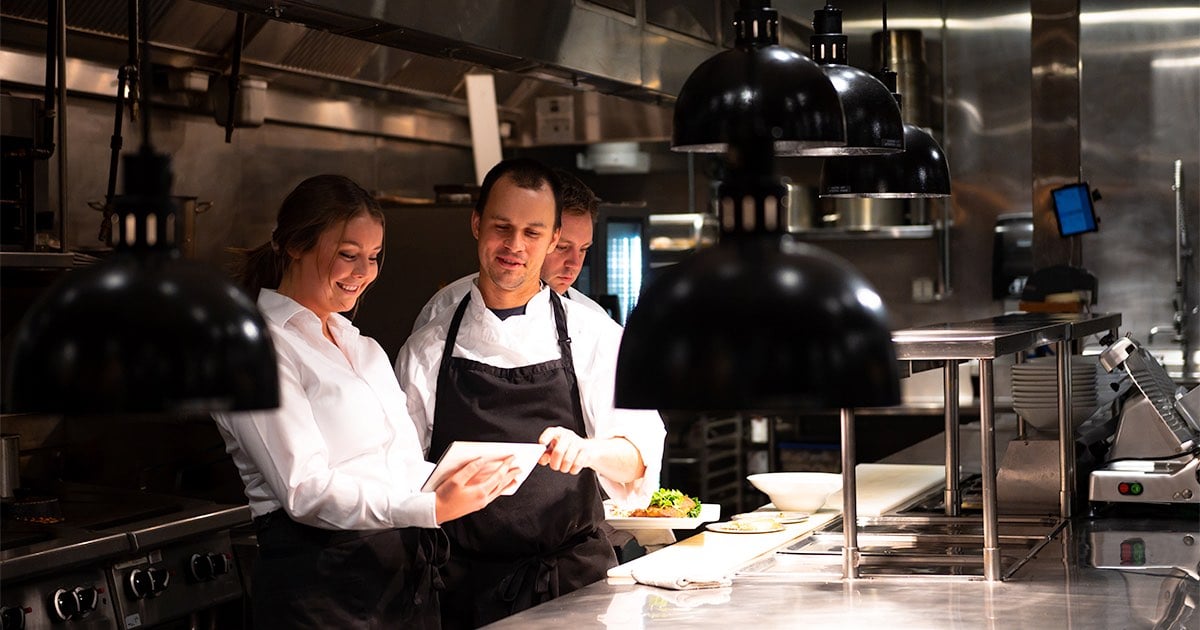Written by SmartSense | Food Safety, Food Service
Explore solutions built for your industry
Our customer-proven solutions monitor medications and food inventories for some of the most recognizable names in the industries of healthcare, food service, and transportation, and logistics. See how our solutions adapt to your industry needs.
SEE SOLUTIONSKroger Health Strengthens Compliance Visibility with SmartSense
Watch The VideoLEARN
Questions? Call +1 (866) 806-2653 to speak to our experts.
Schedule demoQuestions? Contact us.
Call +1 (866) 806-2653 to speak with our experts or get started with a demo.
CONTACT USAbout Us
SmartSense was created to use the power of the Internet of Things (IoT) to help our customers protect the assets most critical to the success of their business.
See our storyCONNECT. PROTECT. RESULTS.
Questions? Call +1 (866) 806-2653 to speak to our experts.
Schedule demoPlease select your login
February 16, 2023
The Modern Restaurant in the Sensing-as-a-Service Landscape
Restaurant management is always searching for proactive ways to increase operational efficiency while complying with safety regulations. Easier said than done, right? Actually, digital solutions that do both are already well established in the industry, proven successful in a variety of applications, and much easier to install, implement, and manage than some tentative executives might imagine.
In this post, we’re going to present three ways IoT’s physical-digital-physical framework helps restaurants enhance operational efficiency:
- Leveraging digital visibility of execution
- Automating workflow management
- Preempting equipment failure
For restaurant operators, employee adoption is critical for the return on investment of purchasing IoT solutions. So-called “digital immigrants,” those employees born into generations less familiar with online and mobile technologies, must be able to understand and operate new systems quickly and easily. Fortunately, the best solutions on the market are already user-friendly, providing internal guidance and training for staff within the solution itself, thereby:
- Improving retention
- Eliminating redundant tasks
- Incorporating added flexibility
- Creating feedback channels
Along with workplace culture, the C-suite and middle management must lead with change management to bolster and motivate staff, including:
- Adoption by using a Gradual-Path model or a Change-Key model
- Seamless user experience
- Training and onboarding
- Digital accessibility
3 Benefits of IoT’s Physical-Digital-Physical Framework

Much of the restaurant industry still relies on “red books,” an outdated manual “paper and pen” method of monitoring and recording data by onsite personnel. Before COVID-19, red books might have remained an option, for at least the short-term. But it’s a new game in the post-pandemic environment, and the rules have changed.
Given remote working options and an ongoing labor shortage, managers need their onsite employees to spend more time engaging customers than performing mundane tasks that can be better handled by digital, remote, automatic, and continuous monitoring solutions.
Today’s modern, connected restaurant situated in a new physical-digital-physical landscape is now able to:
- Reduce the need for employees to complete repetitive tasks
- Shift labor hours to help create a better customer experience and boost customer satisfaction
- Operate remotely and automatically in the absence of staff unavailable to cover a 24-hour schedule
- Monitor cooling assets and collect critical food safety data continuously 24/7, night and day, with no gaps and no guesswork, so that no excursion is ignored
- Stockpile data in the cloud to ensure safe storage, provide proof of compliance, and analyze information to provide predictive insights
In short, a digital solution bypasses all the pitfalls of red books; instead, it offers new benefits: streamlined workflows, automated decision-making, guided action and task completion, maximized execution rates, increased operational efficiency, and better collaboration between management and staff.
Leveraging digital visibility
For risk mitigation and asset protection, it’s impossible to manage what you can’t inspect. That’s why the first step in adopting a physical-digital-physical framework is abandoning paper-based processes, embracing connectivity for critical measurements, and getting visibility into the state of assets across multiple locations.
The digital-physical-digital framework requires IoT devices to collect telemetry data—such as temperature, humidity, traffic, volume, current consumption—so it can be leveraged to identify areas of risk. What is measured should be configured to the unique needs of a restaurant brand’s food safety standards, local and federal regulations, and the specific requirements of the food being served.
Transparency across operations allows corrective actions to take place before an incident occurs. By processing food safety data digitally, managers can proactively generate on-demand documentation and corresponding corrective actions. Embracing digital connectivity also brings greater security to restaurant operations, helping operators meet rigorous standards for access control, encryption, and audit logging.
Automating workflow management
To maximize organizational impact, digital food safety programs improve the existing workflows for facilities management, regulatory compliance, restaurant operations, and risk management. For example, automated alerts for excursion events enable restaurant managers to take critical action and protect product stored in refrigerators, freezers, and walk-in coolers before they are irrevocably damaged, thereby saving thousands of dollars.
Envision a restaurant kitchen operating within a physical-digital-physical framework. A digital sensor detects a temperature reduction inside a freezer caused by overcrowded inventory. The sensor creates a text-based descriptive insight and prompts a physical action from an employee—such as moving the excess inventory to a different freezer with more space. Then, the continuous digital sensing certifies whether the prescriptive action was completed. This feedback loop brings another dimension to the restaurant's security and risk management efforts, promoting loss prevention, product preservation, and labor efficiency.
Predicting equipment failure
Adopting the physical-digital-physical framework provides 24/7 insight into restaurant equipment, ensuring that physical assets maintain product integrity. For example, a power outage or equipment failure could make meeting food safety standards impossible until emergency repairs are completed and electricity is restored.
Continuously monitoring equipment and running the data through predictive models empowers facilities teams with the digital insights to proactively maintain their physical assets and take preventive action before equipment fails. Furthermore, by tracking the performance of different makes and models of equipment, restaurant management can make more informed purchasing decisions based on reliability.
The Importance of Employee Adoption, Satisfaction & Retention

Considering pandemic-related risks and labor shortage difficulties, front-line workers have faced several challenges causing frustration and burnout at alarming rates. Even before the pandemic, front-line workers had long been subject to monotonous tasks, unnecessarily repetitive work, and poor training. According to Workplace from Meta research, 45% of surveyed front-line workers were planning to leave front-line employment completely.
Retail employees are often in flux as they transition to different jobs in search of the right compensation and culture. The competition can take advantage of employee uncertainty and attract significant portions of your labor force with the right incentives.
It is therefore essential for restaurant managers to create a bridge and take care of their employees, especially because employees take care of customers.
Onboarding digital immigrants
Front-line employees feel more valued when they can improve the customer experience rather than when they’re required to complete mundane tasks. If leveraged within the correct outcome-based framework, interconnected technologies have the potential to improve employee performance and retention in a way that impacts critical real-world results.
Digital solutions must be simpler and more seamless than their paper-based legacy tools. The user-friendliness of digital solutions must be easier than writing on paper for full employee adoption, especially for “digital immigrants.” Generations of employees born before or in the early stages of the Web 1.0 through 6.0 revolutions may not be familiar with the nomenclature or interface of digital tools.
Even if digital immigrants are familiar, they must learn to use computing systems that are updated at increasing rates of speed and complexity. Failing to make digital solutions easy to adopt for digital immigrants severely reduces the effectiveness of those solutions and inhibits the growth that could be attained with wider adoption.
Eliminating redundant tasks
For some front-line workers, work is drudgery—which doesn’t have to be the case.
The right tools can largely eliminate repetitive, mundane tasks and provide more time for employees to engage with customers and take part in the more satisfying work of creating a better customer experience.
Front-line workers are often subject to numerous alerts and interruptions during their workday. By implementing tools that reduce alert fatigue with better accuracy and less false positives, management can lessen the burden of information overload for employees.
Creating feedback channels
In addition to structuring more adaptability during the workweek, it is essential to construct robust feedback systems for front-line workers to ensure their voices are heard. The ability to easily provide real-time feedback is especially important in the context of automated guidance and prescriptive workflows. While simultaneously gathering better quality sensor and telemetry data, capturing the inputs from front-line workers about the quality and relevance of the prescriptions they receive will increase the accuracy of future instructions and reduce false positives.
Leading with Change Management

There are several different change management models, but they all boil down to two paths—implement changes gradually or all at once. Both models attempt to answer the question: “How do you create genuine change in an environment where the status quo is deeply rooted in the culture of the organization?”
The Gradual-Path model follows a progression:
- A hybrid of paper-based and digital processes
- A fully digital process
- A digital system that includes exception reporting
- A complete IoT solution providing with prescriptive actions
Companies may take a year or more at each step and then transition to the next step as soon as the current step fails to meet satisfactory requirements.
The Change-Key model overhauls the organization all at once. Operational leadership demonstrates the value of full digitalization, gets consensus about the benefits, and garners full executive support for swift transformation. This approach requires greater flexibility from employees, but any pain or conflict during the transition can be quickly resolved.
Training & onboarding
In general, adoption of new processes by employees tends to be high, with typically only a few outliers unable or unwilling to adapt. Some of those who are resistant will adjust with more training and guidance, eliminating the “unknown.” Given that 54% of the non-federal civilian labor is more than 39 years old, it is tempting to frame the conversation around age. However, resistance to or difficulty with digital technology has more to do with individual employees rather than demographics.
For digital immigrants in the workforce, digital empowerment is riding on the training and onboarding they receive. For front-line workers, instructions need to flow in a descriptive, guided fashion. Solution engineers therefore should keep simplicity as their guiding light: the KISS principle (i.e., Keep it simple, stupid.) should rule during development, testing, and evaluation.
Formalized training during the onboarding process is essential, but employees should not need to refer to training materials to successfully use the digital solution. A plethora of buttons and navigation functions will only slow down the execution of tasks. Instead, options must be minimized and guidance maximized.
Seamless user experience & digital accessibility
Even more important for digital empowerment is seamless UX/UI. When designing a solution, UI/UX strategy is of utmost importance. The well-defined best practices for UI design should be applied to the creation and maintenance of digital products. The UX of the digital solution should inspire confidence in employees, providing them with the on-demand training and guidance they need to be successful.
Another consideration that should not be overlooked is digital accessibility. Digital solutions must be designed in a way that is inclusive. Guidance from the ADA on how to create accessible technology should be consulted as digital solutions are developed and upgraded.
To Modernize Is to Digitize

Today, the sophistication of IoT technology available to the restaurant sector is at an all-time high. Leveraging a physical-digital-physical framework ensures that restaurant management is maximizing assets, human labor, and capital equipment investments.
Digital decisioning and fully optimized food safety technology that securely collects and delivers real-world data about the physical state of assets is essential for building a profitable, waste-reducing restaurant. A self-provisioning, remotely managed solution allows restaurant management to ensure that their security and operations priorities are aligned.
With proper onboarding, effective UI/UX design, and a focus on change management that eliminates the need to maintain the status quo, the potential for digital solutions to generate outsized value for the organization is possible as employees adopt the tools that make their work easier and more meaningful. The pillars of employee retention include building a feedback loop, providing empowering technology, incorporating flexibility, and ensuring that employees are equipped to do the dignified work of providing value to their customers.
Topics:
Food Safety
Food Service
Other Suggested Posts
Why Customer Success Makes the Difference in Your Condition Monitoring Program
If your business objective is to implement an efficient and successful condition monitoring program, gone are the days of “set it and forget it.” Today’s savvy ...
Why K-12 School Cafeterias Are Automating Food Safety
During the COVID-19 pandemic, there were significant disruptions to K-12 school food services nationwide. School nutrition directors were forced to rapidly ...
Frozenomics: Why Freezers Are Becoming America's Financial Lifeline
When times get tough, Americans get creative with how they stretch budgets. That's why today's shoppers are fighting inflation and financial strain with an ...
How Machine Learning Elevates Traditional Temperature Monitoring
While a minority of food companies and healthcare organizations continue to manually collect temperature logs to meet compliance regulations, most enterprises ...
Creating a Customer-Centric Food Chain with Sensing-as-a-Service
The food service industry is undergoing an era of labor uncertainty and demand volatility. The reasons are many and complex: the rise of e-commerce, supply ...
Subscribe to the SmartSense Blog
Stay up-to-date on the evolution of IoT connectivity.
CONNECT. PROTECT. RESULTS.
Learn how our complete critical
environment monitoring solution will help you
connect and transform your business.
Call +1 (866) 806-2653 to speak with our industry
experts or get started by
requesting a demo.